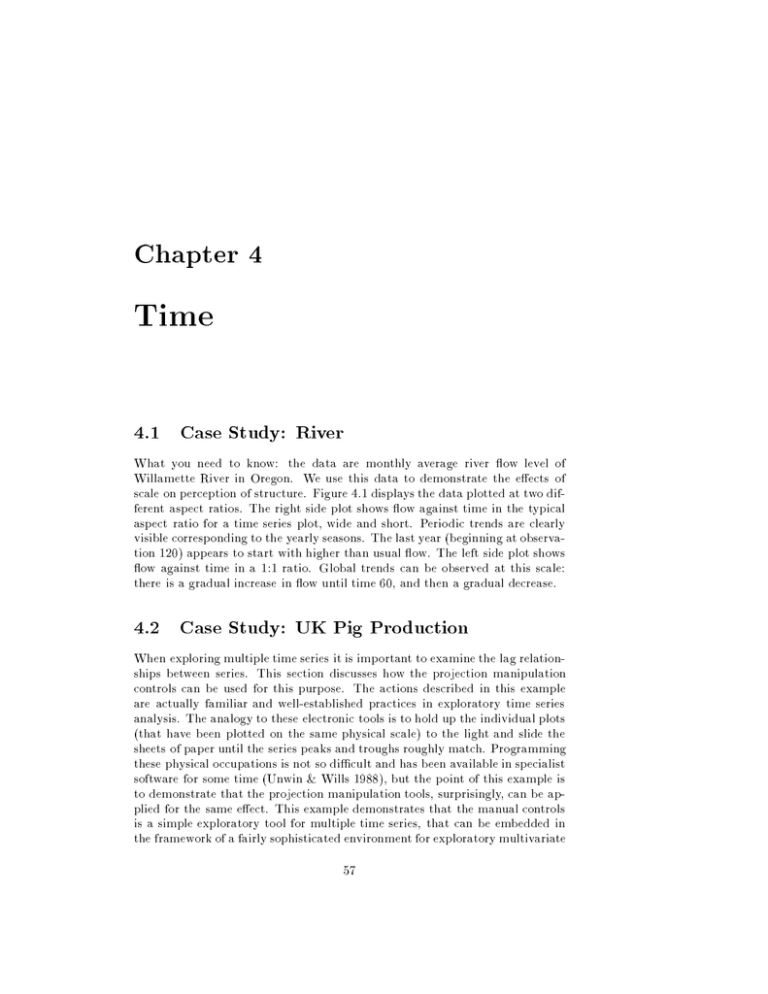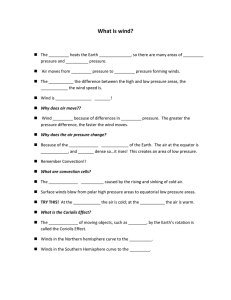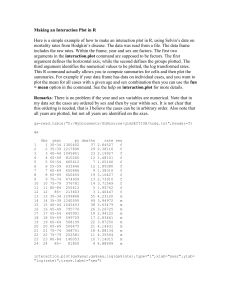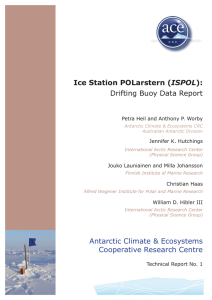Document 10639372
advertisement

Chapter 4
Time
4.1 Case Study: River
What you need to know: the data are monthly average river ow level of
Willamette River in Oregon. We use this data to demonstrate the eects of
scale on perception of structure. Figure 4.1 displays the data plotted at two different aspect ratios. The right side plot shows ow against time in the typical
aspect ratio for a time series plot, wide and short. Periodic trends are clearly
visible corresponding to the yearly seasons. The last year (beginning at observation 120) appears to start with higher than usual ow. The left side plot shows
ow against time in a 1:1 ratio. Global trends can be observed at this scale:
there is a gradual increase in ow until time 60, and then a gradual decrease.
4.2 Case Study: UK Pig Production
When exploring multiple time series it is important to examine the lag relationships between series. This section discusses how the projection manipulation
controls can be used for this purpose. The actions described in this example
are actually familiar and well-established practices in exploratory time series
analysis. The analogy to these electronic tools is to hold up the individual plots
(that have been plotted on the same physical scale) to the light and slide the
sheets of paper until the series peaks and troughs roughly match. Programming
these physical occupations is not so dicult and has been available in specialist
software for some time (Unwin & Wills 1988), but the point of this example is
to demonstrate that the projection manipulation tools, surprisingly, can be applied for the same eect. This example demonstrates that the manual controls
is a simple exploratory tool for multiple time series, that can be embedded in
the framework of a fairly sophisticated environment for exploratory multivariate
57
Flow
9.5 10.0 10.5 11.0 11.5
9.0
8.5
0 10 20 30 40 50 60 70 80 90100110120130
8.0
8.5
9.0
910.0
.510.5
11.0
11.5
Flow
Time
0 10 20 30 40 50 60 70 80 90100110120130
Time
Figure 4.1: Willamette river ow data at two dierent aspect ratios. Top plot
shows 1:1 ratio (contracted in time), which reveals long term trends, such as
the up then down. Bottom plot shows long time axis, revealing local seasonal
trends.
58
SB
Profit
Gilts
Figure 4.2: The series indicator variable
is manipulated into the vertical
projection, thus separating the series, and the indicator variables for the
and series are manipulated into the horizontal projection, thus lagging the
series on the other series.
I ndic
Gilts
SB
59
data analysis. It is necessary to preprocess the data, but this can be easily automated for general multiple time series. (Indeed an S function is available on the
web page for this article http://www.public.iastate.edu/dicook/research/papers/manip.html.)
The data has 5 indicators of pig production in the United Kingdom, with
measurements taken quarterly over a 12 year period from 1967 until 1978. The
data can be found in Andrews & Herzberg (1985). The series are as follows:
Series 1 Number of sows in pig for the rst time, that is, a measure of intake
into the breeding herd (
).
Series 2 Ratio of all-pig price to all-fattener feed price (
).
Series 3 Ratio of sow and boar slaughter to total breeding herd size, that is,
the removal of pigs from the breeding herd ( ).
Series 4 Number of clean pigs (meat) slaughtered ( ).
Series 5 Actual breeding herd size (
).
The data is preprocessed in the following way:
1. Each series is standardized.
2. The 5 series are concatenated (Pigs):
GI LT S
P ROF I T
SB
CP
H ERDSZ
GI LT S1 ; : : : ; GI LT S48 ; P ROF I T1; : : : ; P ROF I T48;
: : : ; H ERDSZ1 ; : : : ; H ERDSZ48
3. New variables are created:
(a) Series indicator (Indic): 1
(b) Lag indicators (5 variables)
48
48
48
48
48
z }| { z }| { z }| { z }| { z }| {
:::
12
:::
23
:::
34
:::
45
:::
5
48
48
48
48
48
:::
:::
:::
:::
:::
:::
:::
:::
:::
:::
:::
:::
:::
:::
:::
:::
:::
:::
:::
:::
:::
:::
:::
:::
:::
Gilts z,1 }| , 1{ z1 }| 1{ 1z }| 1{ 1z }| 1{ z1 }| 1{
Profit 1 1 ,1 , 1 1 1 1 1 1 1
SB
1 1
1 1 ,1 , 1 1 1
1 1
CP
1 1
1 1
1 1 ,1 , 1 1 1
Herdsz 1 1 1 1 1 1 1 1 ,1 , 1
The Indic variable is used to separate the series by manipulating this variable into the vertical projection, leaving the series sequentially plotted vertically
(Figure 4.2). Any one of the series can be lagged positively or negatively on the
remaining series by manipulating the indicator variable for the series into the
horizontal projection. For example, in Figure 4.2 the Gilts series has been
lagged on the rest. We have stopped at a projection where the Profit peaks
match the Gilts peaks. The lag relationship looks to be about 3 quarters,
or 9 months. This is interpretable given that the gestational period is about 4
months and clean pigs are usually slaughtered between 4 to 6 months of age.
60
4.3 Case Study: TAO Buoys
4.3.1 Data description
The El Ni~no/Southern Oscillation (ENSO) cycle of 1982-1983, the strongest
of the century, created many problems throughout the world. Parts of the
world such as Peru and the Unites States experienced destructive ooding from
increased rainfalls while the western Pacic areas experienced drought and devastating brush res. The ENSO cycle was neither predicted nor detected until it
was near its peak. The need for an ocean observing system to support studies of
large scale ocean-atmosphere interactions on seasonal-to-interannual time scales
was highlighted.
This observing system was developed by the international Tropical Ocean
Global Atmosphere (TOGA) program. The Tropical Atmosphere Ocean (TAO)
array consists of nearly 70 moored buoys spanning the equatorial Pacic, measuring oceanographic and surface meteorological variables critical for improved
detection, understanding and prediction of seasonal-to-interannual climate variations originating in the tropics, most notably those related to the ENSO cycles.
The rst buoys were operational in March 1980, and more have been added
since. This data comes from this array of buoys. Daily updates on the buoy
recordings are at http://www.pmel.noaa.gov/toga-tao/home.html. The full
data set that we formatted for use here has 178080 measurements. This is
large enough that working with this entire data set requires some of the tricks
described in the chapter on large data. For this section, though, we focus on
re-structuring the data in dierent ways, and looking at these subsets. The
variables recorded in the data set are:
Latitude,Longitude
Values returned by the buoy of its actual physical location
year, month, day
Time measurement taken
Zonal Winds
Winds from the west<0, east>0
Meridional Winds
Winds from the south<0, north>0
Relative Humidity
Air Temperature
Sea Surface Temperature
4.3.2 Querying Drift
Figure 4.3 displays the location variables of a subset of 28 buoys in the southeastern Pacic. It is interesting to note that the buoys drift around some, some
more than others. Using linked brushing we can query the points that indicate
a buoy drifting fom its mooring, and nd out the day, month and year that this
happened (Figure 4.3). Its looks like someone was aware of the drifting and
xed the problems: all the time periods are consecutive and in the past.
4.3.3 Cycling over time
Variables were re-structured to have each variable correspond to a year's monthly
average measurements on air temperature for two dierent locations. Anima61
0
-2
-4
-8
-6
latitude
-180
-160
-140
-120
-100
5
month
10
longitude
80
85
90
95
100
5
month
10
year
0
10
20
30
day
Figure 4.3: (top) Latitude vs longitude of buoys in the south-eastern Pacic,
showing how some drift around a lot. (Middle, Bottom) Querying the drifting
shows it to be consective days, and the drifting has been corrected in all cases.
62
tion over the year can be done to assess year-to-year trend. This is a common
technique for handling time series. The plots in Figure 4.4 illustrate a static representation cycling through the monthly air temperature measurements for two
dierent buoys over the years 1993-1998. The year 1993 was the year that the
buoy at 180o W installed. (Missing values are plotted as the minimum value,
20o . And the air temperature is plotted as raw values, not standardized.)
Some interesting features are visible. The air temperature for the buoy further
out in the ocean is generally higher than the buoy close to the coast. Typically air temperature at 110 starts o reasonably high and then dips lower.
In contrast, air temperature at 180 tends to start lower and get higher. (The
standardize scale would be better for assessing this relative trend.) The year
1997 is very interesting. The air temperature out to sea remains high all the
year, and the air temperature near the coast continues to climb higher at the
end of the year rather than decline. (This buoy stopped recording in May, June
and July.) Indeed this trend continues on to 1998 also. This period marked an
extreme El Ni~no event.
C
4.3.4 Correlation Tour
This section illustrates exploring multivariate time using the correlation tour.
To do this we have taken the measurements made by one buoy 2o S and 110o W,
including all wind, humidity and temperature variables. Monthly averages for
each of the variables for two years (1993, 1997) were used. Cases with missing
values on any variables were excluded from the plot, hence the break in the
time series for 1997. The correlation tour allows for two separate 1D tours
to be run on the horizontal and vertical axes using two dierent subsets of
variables. In this example, we x the horizontal axis to time, and tour on the
5 measured variables on the vertical axis. The correlation tour can be helpful
in detecting multivariate temporal outliers, a point that is on the edge of two
or more variables. In addition, the correlation tour may be useful in detecting
relationships when two or more time series are displayed. Figure 4.5 displays
three snapshots of the tour on the tao data. The top plot shows the average of
the two wind variables against time, and the middle plot shows a contrast of
the two wind variables plotted against time. The two years look fairly similar
in both of these plots. The bottom plot shows an average of three variables
sea surface temperature, air temperature and meridional winds. Here there is
a very large dierence between the two years in the latter half of the year, the
start of an El Ni~no event. It seems that meridional winds play an important
role in the event.
4.4 Case Study: Telephone Usage
63
AirT93
2022242628
180W
110W
1
2
3
4
5
6
7
8
9 10 11 12
180W
2022242628
AirT94
Month
110W
1
2
3
4
5
6
7
8
9 10 11 12
180W
2022242628
AirT95
Month
110W
1
2
3
4
5
6
7
8
9 10 11 12
180W
2022242628
AirT96
Month
110W
1
2
3
4
5
6
7
8
9 10 11 12
180W
110W
2022242628
AirT97
Month
1
2
3
4
5
6
7
8
9 10 11 12
8
9 10 11 12
AirT98
2022242628
Month
180W
110W
1
2
3
4
5
6
7
Month
Figure 4.4: Air temperature vs month for the years 1993-1998, for latitude 2o S,
and (110o W,180oW).
64
1997
1993
zon.winds
mer.winds
month
1997
1993
mer.winds
month
zon.winds
1997
1993
mer.winds
s.s.temp.
air.temp.
month
Figure 4.5: Exploring multivariate relationships in time.
65
66









